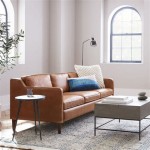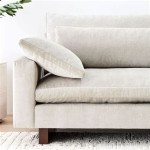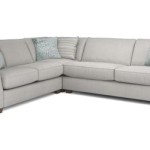Living Room Colors That Harmonize With a Brown Sofa
A brown sofa is a versatile and enduring piece of furniture, often serving as the foundational anchor of a living room. Its neutral tone provides a canvas upon which a variety of color palettes can be implemented, each creating a distinct ambiance and aesthetic. The selection of appropriate wall colors, accent hues, and material textures is crucial in achieving a cohesive and visually appealing living space. This article explores the diverse range of color options that complement a brown sofa, offering insights into how to create different moods and styles.
The inherent warmth of brown allows it to pair well with both warm and cool colors, affording a substantial degree of design flexibility. The specific shade of brown also significantly influences the optimal color pairings. For instance, a dark chocolate brown sofa may benefit from lighter, brighter colors to prevent the room from feeling too heavy, while a lighter tan or beige sofa can accommodate deeper, richer hues. Careful consideration of natural lighting and room size is also necessary to ensure the chosen colors create the desired effect.
Understanding the Undertones of Brown
Before embarking on selecting complementary colors, it is essential to identify the undertones present within the brown of the sofa. Brown, despite its seemingly neutral nature, can possess warm (red, orange, yellow) or cool (gray, green, blue) undertones. Identifying these undertones will guide the color selection process, ensuring a harmonious and balanced aesthetic. For instance, a brown sofa with warm undertones will naturally pair well with other warm colors like golds, rusts, and earthy greens. Conversely, a brown sofa with cool undertones will complement cooler colors such as blues, grays, and purples.
Analyzing the lighting conditions in the living room is also crucial in determining the undertones. Artificial lighting can subtly alter the perceived color of the sofa. Examining the sofa under both natural and artificial light will provide a more accurate assessment of its true hue and undertones. Fabric swatches and paint samples should also be viewed in the room’s lighting to ensure the chosen colors interact favorably with the existing furniture and décor.
Once the undertones are identified, the process of selecting complementary colors becomes more intuitive. Choosing colors that share similar undertones will create a cohesive and harmonious palette. Conversely, selecting colors with contrasting undertones can introduce visual interest and dynamism, but requires careful consideration to avoid clashing or imbalance.
Creating a Calm and Neutral Palette
For a serene and understated living room, a neutral palette is an excellent choice. This approach focuses on using variations of whites, grays, beiges, and creams to create a calming and sophisticated atmosphere. These colors allow the brown sofa to remain a focal point while providing a backdrop that is both timeless and versatile. A neutral palette also allows for the introduction of textured elements and patterns without overwhelming the space.
White walls, in various shades from clean stark white to warmer off-whites, offer a classic and adaptable option. Off-whites with subtle yellow or beige undertones can soften the overall look and create a more inviting ambiance. Gray, ranging from light silver to deep charcoal, provides a cooler and more modern alternative. Light grays can create an airy and spacious feel, while darker grays can add depth and drama. Beiges and creams offer a warmer and earthier feel, complementing the natural tones of the brown sofa. These colors can be used independently or in combination to create a nuanced and layered neutral palette.
Accent colors within a neutral palette should be subtle and complementary. Soft blues, greens, or muted purples can add a touch of color without disrupting the overall tranquility. Metallic accents, such as gold or silver, can introduce a hint of glamour and sophistication. Natural textures, such as wood, linen, and wool, can add warmth and visual interest to the space. Incorporating plants and greenery further enhances the calming and natural feel of the room.
Adding Depth with Bold and Vibrant Colors
For those seeking a more dynamic and expressive living room, incorporating bold and vibrant colors alongside a brown sofa can create a visually stimulating and personalized space. This approach requires careful consideration to ensure the colors are balanced and harmonious, avoiding visual overload. The key is to use bold colors strategically, as accents rather than dominating the entire room.
Deep jewel tones, such as emerald green, sapphire blue, or ruby red, can create a luxurious and sophisticated look. These colors work particularly well with darker brown sofas, adding depth and richness to the space. When using jewel tones, it is important to balance them with lighter neutrals to prevent the room from feeling too dark or overwhelming. Accent pillows, throws, and artwork can be used to introduce these colors without committing to painting entire walls.
Terracotta, mustard yellow, and burnt orange are warm and earthy colors that complement brown sofas beautifully. These colors evoke a sense of comfort and warmth, creating an inviting and welcoming atmosphere. They work particularly well in bohemian or rustic-inspired living rooms. These colors can be incorporated through accent walls, rugs, or decorative accessories. When using warm colors, it is important to consider the natural lighting in the room, as they can appear more intense in bright sunlight.
Teal, turquoise, and coral are vibrant and refreshing colors that can add a pop of energy to a living room with a brown sofa. These colors work particularly well in coastal or contemporary-style living rooms. They can be used sparingly, as accents, to create a visually striking contrast against the neutral brown. Artwork, vases, and cushions are ideal for incorporating these vibrant hues.
Considering the Impact of Lighting and Texture
The interplay of lighting and texture is crucial in determining the overall success of any color scheme. The way light interacts with different colors and textures can significantly alter their appearance and impact on the room. Natural and artificial lighting should be carefully considered, as well as the texture of the walls, furniture, and accessories.
Natural light can enhance the vibrancy of colors, making them appear brighter and more saturated. Rooms with ample natural light can typically handle bolder and more intense colors without feeling overwhelming. Conversely, rooms with limited natural light may benefit from lighter and more reflective colors to maximize brightness and create a more spacious feel. Artificial lighting can be used to supplement natural light and create different moods within the room. Warm lighting can create a cozy and inviting atmosphere, while cool lighting can create a more modern and sophisticated look.
The texture of walls, furniture, and accessories can also significantly impact the overall color scheme. Matte finishes tend to absorb light, creating a softer and more muted look. Glossy finishes, on the other hand, reflect light, creating a brighter and more vibrant look. Textured walls, such as those with exposed brick or wood paneling, can add depth and visual interest to the room. The texture of fabrics, such as velvet, linen, or wool, can also affect the way colors are perceived. Velvet, for example, tends to deepen the saturation of colors, while linen tends to soften them.
Layering different textures and finishes can create a more dynamic and visually appealing space. Combining smooth and rough textures, matte and glossy finishes, and light and heavy fabrics can add depth and complexity to the room. It is important to ensure that the textures and finishes complement the overall color scheme and create a cohesive and balanced look.
Ultimately, the selection of colors that harmonize with a brown sofa is a highly personal decision. It depends on individual preferences, the desired mood and style, and the specific characteristics of the living room. By understanding the undertones of the brown sofa, considering the impact of lighting and texture, and experimenting with different color combinations, one can create a living space that is both visually appealing and personally satisfying.

Dark Brown Sofa In Small Living Room Modern Eming Your Personality Colors Couch Design

Like Pillows And Colors Used For Upstairs Living Room Decor Brown Couch

Adorable Dark Brown Living Room And Best 10 Sofa Decor Ideas On Home Design Couch

Ideas For Wall Colors That Go With Brown Furniture The Inside

How To Style A Brown Sofa Mohawk Home

What Color Goes With A Brown Leather Sofa Studio34

Paint Color Is A Possibility Brown And Blue Living Room Sofa

Brown Sofa With Two Chaise Lounges Eclectic Living Room

Secrets From Our Color Expert How To Style Brown Furniture The Roomplace

Dark Brown Sofa Living Room Ideas Tips And Tricks








